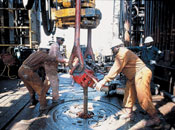International
Really big projects and investmentsGood fortune continues to smile on ExxonMobil’s exploration campaign offshore Angola. The firm announced last month that it had struck its 10th oil discovery in three years in Angolan waters, a blistering pace by anyone’s standards. The latest find, Mbulumbumba 1, is in deepwater Block 15, 220 mi northwest of Luanda. It was drilled to a 12,400-ft TD in 2,790 ft of water. Test results had not been disclosed at press time. Mbulumbumba follows nine previous discoveries, including Hungo, Kissanje, Marimba and Dikanza in 1998; Chocalho and Xicomba in 1999; and Mondo, Saxi and Batuque in 2000. ExxonMobil now estimates Block 15’s recoverable reserve potential at 3.5 billion boe and refers to the tract as a "world-class development opportunity." The company notes that multiple field development projects are underway, with the first oil due to go onstream sometime in 2004.
Indonesian flowrate goes higher. Gulf Indonesia Resources, a subsidiary of Gulf Canada Resources, said that its Bukit Tua 1 discovery is more prolific than previously announced. A second test of the well in the Ketapang PSC, offshore East Java, flowed 4,450 bopd through a 1-in. choke from an interval between 6,346 and 6,386 ft. This is in addition to the first test of a cased interval between 6,466 and 6,488 ft, where oil flowed at a 2,800-bpd rate through a 1-in. choke. "The combined flowrate of 7,259 bopd from the tests of two zones in the Bukit Tua 1 well demonstrates the quality of the prospects in this block," said Cliff Zeliff, Gulf Indonesia’s vice president of exploration. "We are planning further testing on shallower zones in the well." South Pacific developments. Speaking of ExxonMobil, the firm’s Esso Australia Resources affiliate has signed a long-term supply agreement with Duke Energy International, enabling the introduction of natural gas supplies to Tasmania. The supply agreement will provide unspecified "substantial" volumes of gas from Esso Australia’s Bass Strait fields for up to 15 years, starting in 2002. Supplies will be relayed via production facilities at Longford, Victoria. Esso and partner BHP Petroleum won the contract after "demonstrating access to long-term reserves, and willingness and ability to supply competitively-priced gas over a long period." To the east, in New Zealand, Swift Energy Co.’s Rimu-A3 well found hydrocarbon shows in the Upper Tariki sandstone at an 11,647-ft TD. This is 148 ft updip to the Upper Tariki zone in Rimu-A1. The firm resumed drilling the well with an LWD tool, to a 15,744-ft TD, to test the Upper Rimu, Lower Rimu and Lower Tariki formations. At press time, this was expected to take another 30 days. Swift said that it began extended production testing of Rimu-B2 on April 1. Initial flowrate was 658 bopd and 5.2 MMcfgd. The firm also is moving ahead with design and construction of Rimu production and processing facilities. To the north, in Papua New Guinea, Oil Search Ltd. said that drilling activities will begin soon in two Highlands ventures in which it participates. In License PDL2, operator Chevron’s horizontal well is targeting a pool of oil not presently produced as part of the Kutubu field development plan. Meanwhile, in PPL138, operator ExxonMobil’s Bakari wildcat will test a prospect on trend with, and immediately northwest of, Moran Central oil field. ExxonMobil and Oil Search believe that up to 200 million bbl of oil may be found there. Rats again. From our oddities file come two items of dubious distinction. First, ABC News reported that rats are back on the menu at Vietnamese restaurants in the Mekong Delta. Rains had flooded the delta last year, wiping out the area’s plentiful rats. Now, nearly a year later, the floods are gone, and the rats have returned, to the delight of local consumers. Although a menace to delta crops, rats are a popular protein source in rural Vietnamese diets. After the floods, bars and restaurants experienced a shortage last winter that did not last long, thanks to the rodents’ quick reproduction rate. So far this year, up to 270,000 rats have been caught on 84,000 acres of rice fields in Bac Lieu province, said the U.S. Embassy in Hanoi. Three tons were brought to market daily, according to Bac Lieu’s Agriculture and Rural Development Service. A good cut of rat meat can cost up to $2/kilo ($1.10/pound). This should motivate the focal point of our other story, a chef in Hong Kong’s Kowloon section, who has found fame trampling rats in his restaurant. Identified only as "Uncle Kai’’ by the Apple Daily newspaper, this chef killed 60 rats in the first six days after joining a new restaurant in Kowloon this year. Kai killed nearly 200 rats in the eatery where he worked last year, winning him the nickname, "the anti-rat king.’’ Hailing from China’s Sichuan province, Uncle Kai
begins his killing spree before dawn each day. Donning rubber boots and gloves, he blocks off a section of the
restaurant where the rodents hide, leaving only one exit. He then scares them out and crushes them underfoot
as they try to escape. At press time, the Food and Environmental Hygiene Department had not decided whether to
take action against Kai’s eatery, noting that 57,639 rats were killed in Hong Kong in 2000.
|
- Applying ultra-deep LWD resistivity technology successfully in a SAGD operation (May 2019)
- Adoption of wireless intelligent completions advances (May 2019)
- Majors double down as takeaway crunch eases (April 2019)
- What’s new in well logging and formation evaluation (April 2019)
- Qualification of a 20,000-psi subsea BOP: A collaborative approach (February 2019)
- ConocoPhillips’ Greg Leveille sees rapid trajectory of technical advancement continuing (February 2019)




